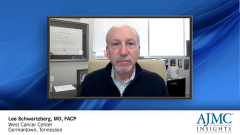
Considerations for Chemotherapy-Induced Neutropenia Prophylaxis
Suggestions regarding when it is appropriate to initiate chemotherapy-induced neutropenia prophylaxis in patients with cancer and goals of therapy.
Episodes in this series

Lee Schwartzberg, MD, FACP: It’s interesting that when you do careful analysis of various chemotherapy regimens across the board, the cycle that is at greatest risk for CIN [chemotherapy-induced neutropenia] and FN [febrile neutropenia] is the first cycle of any regimen. That may be because the bone marrow has not been primed to expand its neutrophil precursors until there is an insult to it, which occurs with myelosuppressive chemotherapy. Therefore, it’s important for clinicians to think about prophylaxis against neutropenia before they start a new regimen, not afterward.
In fact, about 50% of episodes of febrile neutropenia occur with the first cycle of therapy regardless of which treatment you’re giving. A clinician should be evaluating the risk of myelosuppression from the chemotherapy, along with the patient risk factors, along with tumor risk factors, to make a decision whether prophylaxis against CIN should be given with the first cycle of any new regimen.
If a patient is to get a myelosuppressive chemotherapy, the clinician should think about prophylaxis against CIN, and we have prophylactic measures that are effective. Keeping the neutrophil count high, above that 1000 [per μL] point, through the entire cycle of therapy and avoiding the nadir count, which occurs with myelosuppressive chemotherapy at some predictable time, usually in the middle of the cycle, is the goal, because if we can do that effectively then the patient will not be at risk for febrile neutropenia. The patient will not be at risk for all the complications of neutropenia, including hospitalization potentially, and the patient will not be at risk for a dose delay or a dose modification. Therefore, the resource utilization could be dramatically lower if prophylaxis is appropriately employed prior to initiating a new regimen of myelosuppressive chemotherapy.
Newsletter
Stay ahead of policy, cost, and value—subscribe to AJMC for expert insights at the intersection of clinical care and health economics.



























































